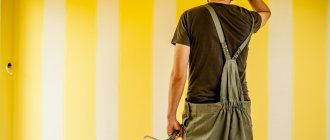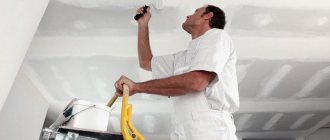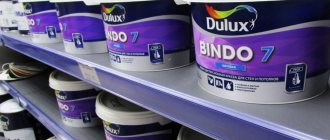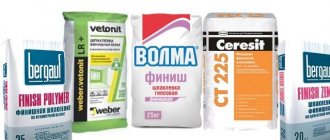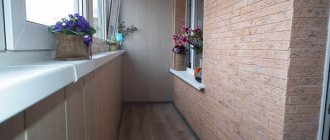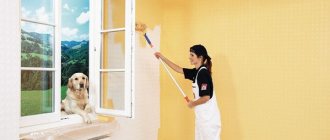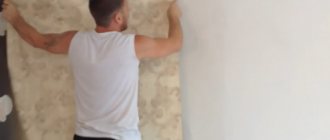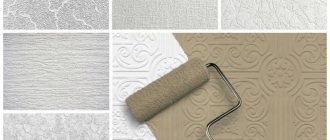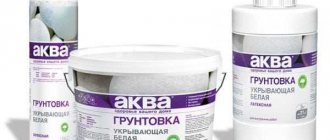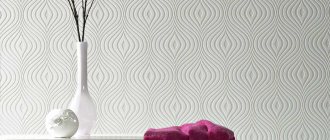Types of wallpaper that can be painted
On an unpasted wall, if it is painted, defects will appear over time. Decorating walls with wallpaper allows you to avoid this. Moreover, if you hang wallpaper and then paint it in the desired color, this can mask all the flaws and surface defects.
Tip 2 – The color will look richer on a papered wall.
Thanks to the relief structure, wallpaper is able to convey shades better. It is also very convenient to paste over uneven walls with relief materials. If you paint a wall without wallpapering, then it will be impossible to hide the unevenness; even the smallest grains of dust can be noticeable.
More details about the types of trellises are written in the article on how to hang wallpaper on the ceiling yourself. Now we will only list their main types:
- paper;
- vinyl;
- non-woven;
- liquid;
- glass wallpaper.
Carry out the gluing correctly; to do this, read the article on how to hang wallpaper yourself.
Paint: basic selection rules
Multi-colored mixtures for painting wallpaper will refresh the room at any time. This type of finish is suitable for those who like frequent repairs, when there is no need to remove the base, but you can simply change its shade. Canvas paint can create a sophisticated, sophisticated finish. When choosing a material, it is necessary to take into account the protective functions, features, and decorativeness of each type. A high-quality mixture should not contain chemically active solvents. Each type of wallpaper uses its own paint:
- Water-based. The base is PVA. Suitable for dry, dark rooms only. The painted surface cannot be washed because the mixture is water soluble;
- Latex. Used in the kitchen, bathroom due to increased moisture resistance, resistance to abrasion, and sunlight;
- Acrylic. Universal resin-based composition. Composite components increase the wear resistance of walls. After quick drying, a breathable layer is formed between the wall and the wallpaper.
How to calculate the required amount of paint
The first thing to do before starting repair work is to prepare the necessary tools and calculate the paint consumption. The amount of mixture will depend on the area of the area to be painted. It is necessary to measure the height of the ceiling, the width of the area to be painted, subtract the size of openings, windows, and untreated coatings.
Typically, manufacturers indicate the consumption on liquid paint cans based on the type of wallpaper. If you need to paint the walls several times, this figure increases by at least one and a half times. Approximately 150-200 g of paint will be needed per square meter. Wallpaper with rough surfaces (glass wallpaper) in this regard is much more economical than paper.
Painting effect
The final result largely depends on the coloring composition. And what’s interesting is that the wall can be repainted a different color over time. The better the base, the more times you can repaint the wall.
Tip 3 – even simple paper wallpaper can be painted up to 5 times. Vinyl can be repainted up to 10 times. You can change the color of non-woven wallpaper 10-15 times. The liquid type cannot be repainted to a different color, unless you can change the shade. Fiberglass wallpaper is suitable for repeated repainting.
Also, the number of repaintings depends on the composition. There are paint and varnish compositions that, after drying, form a film on the surface, which prevents the wallpaper from breathing. Due to the formation of the film, fungus may develop, and the wallpaper may become deformed. If you are struggling with mold, be sure to read the article on how to get rid of fungus on the wall in an apartment.
How to paint wallpaper correctly
To properly paint the wallpaper you will need:
- roller (one or more different sizes);
- tray (preferably with a squeezing mesh);
- container for diluting dye;
- small brush for corners and areas along baseboards;
- masking tape;
- cloth or sponge to remove accidental drops;
- film for protecting floors and furniture;
- stepladder, chair or telescopic handle for a roller.
Tools needed for painting wallpaper
Before painting, the surface must be checked for defects. Glue the peeled corners of the canvases, pierce the air bubbles with a needle. If it was necessary to use glue to eliminate errors, painting should not begin earlier than in a day. Only dry surfaces can be painted.
The next step is to clean the wallpaper from dust and dirt. To do this, use a broom, a dry rag, or better yet, a vacuum cleaner at low power. Then the canvases are degreased by wiping with a sponge soaked in soapy water.
Wait until the surface is dry and begin painting. Before painting, non-woven and glass wallpapers are primed. The primer mixture (primer) is applied with a roller or brush in 1-2 layers. You can apply the paint after the primer has completely dried.
The color mixture is diluted and tinted immediately before application. It is better to pour a small amount into the tray and close the container with the working material to prevent it from drying out. Any paint is diluted in accordance with the manufacturer's instructions - the consistency should be similar to liquid sour cream. Before starting work, it is useful to roll velor and fur rollers with masking tape so that they do not leave lint during painting. The optimal temperature in the room for painting work is 17-25 degrees, the windows are closed.
Having completed the preparatory work, begin painting:
- use a small roller or brush to paint strips up to 10 cm wide along the baseboards;
- paint the relief elements with a brush;
- Using a roller well soaked in dye, paint the main part of the surface from top to bottom. Do not keep the roller in one place for a long time;
- If blisters appear on the wallpaper during the painting process, pierce them with a needle and glue these parts of the canvas to the wall.
The second coat of paint may be applied only after the first has completely dried.
If you want to apply a design to the wallpaper, use a textured roller, stencil or stamp.
Textured roller
Which paint is better
The most popular types of paints, top varieties:
- With acrylic composition.
- Water-based.
- Latex.
The acrylic variety is considered the most popular. The use of acrylic composition allows you to achieve high strength and moisture resistance. And due to the variety of color shades, you can experiment and implement interesting design solutions. Some compositions emit harmful chemicals when evaporating - this is not about acrylic. This is a completely harmless substance suitable for painting wallpaper.
After painting with acrylic composition, the surface can be washed. Due to the moisture-repellent properties of acrylic, it can be used to paint walls in apartments with high humidity. But when painting paper wallpaper with acrylic paint, the canvas becomes significantly heavier. Because of this factor, the number of possible repaintings of paper trellises is reduced.
Tip 4 - If you want the most affordable option, choose a water-based composition.
But water-based emulsion has a number of disadvantages compared to traditional types of paint. Among them:
- fragility;
- washes off with water;
- fades in the sun.
Water-based compositions are more suitable for finishing the ceiling. If it is applied to wallpaper, then most often it is applied to paper. Also, water-based emulsion is used to cover the surface treated with decorative plaster.
Latex paint is considered to be of the highest quality compared to other varieties. High moisture-resistant properties, absence of harmful substances, high-quality structure - all this makes latex one of the best. But the price of latex composition is higher. One of the relative disadvantages is the lack of color saturation. Latex will help achieve soft color shades.
The latex composition should be applied in a thin layer as quickly as possible. The fact is that latex dries very quickly, which limits the time it can be applied to the surface. If you delay, smudges and noticeable transitions will form. The dried coating easily allows air to pass through. Strength is determined by the degree of gloss in the composition.
How to choose paint
When choosing paint for wallpaper, take into account the walls (or ceiling) in which room will be painted. This way you can understand what impact the surface will be exposed to:
- pollution;
- touching with hands;
- humidity;
- high (low) temperature;
- influence of ultraviolet radiation, etc.
Taking these circumstances into account will help you choose a dye with the desired characteristics.
The environmental friendliness of the coloring composition should also be taken into account. Even the most natural canvas under a layer of heavy oil paint will stop “breathing.”
When painting wallpaper, experts advise choosing the following types of paint:
- water-based;
- water-dispersed;
- latex;
- acrylic.
“Water emulsion” is the most environmentally friendly and affordable type of coloring mixture. It is safe, perfectly breathable, easy to apply and does not peel off. When the water emulsion dries, there is no odor.
Depending on the filler, water-based paint is divided into mineral, silicone, silicate, and acrylic. Each type has its own characteristics:
- mineral - easy to apply, but does not last long, is afraid of moisture. Surfaces painted with it cannot be washed;
- acrylic - durable and elastic, but expensive;
- silicate – durable, but does not tolerate high humidity;
- silicone - protects walls from mold, but is more expensive than others.
Water-dispersion paint is prepared on the basis of water dispersion and binding components (acrylic, latex, polyvinyl acetate (PVA)).
PVA-based dye makes the painted surface durable, but vulnerable to moisture. Canvases coated with this paint require dry cleaning only. Therefore, this paint should not be used for painting walls in the bathroom or kitchen. But it is resistant to ultraviolet radiation and retains its original appearance for a long time.
Latex water-dispersion paint is not afraid of either dirt or water. Acrylic – even high humidity is not dangerous. Water-dispersion paint is more durable and affordable compared to water-based paint.
Latex paint contains rubber particles and makes the coating waterproof. Therefore, wallpaper painted with it can be washed frequently with water and detergent. Latex paint is suitable for painting walls in the bathroom or kitchen.
Advantages:
- breathable;
- dries quickly;
- does not release toxins;
- protects wallpaper from fading.
Acrylic paint allows air to pass through and prevents the appearance and proliferation of microorganisms. It forms a moisture-resistant film on the painted surface, which protects the walls from dampness. Acrylic paint:
- non-toxic;
- dries quickly;
- resistant to physical impact.
These properties allow it to be used in a child’s room and bedroom.
Paints vary in reflective ability:
- glossy - reflects light, creating the effect of a mirror surface. Helps visually expand a small room;
- matte (semi-matte is also available) – hides surface defects and also creates coziness in the room, dimming bright light;
- satin - has a moderate shine, reminiscent of the shine of satin fabric.
The next step is choosing a color. You can buy ready-made paint in the color you like or tint it white. This is easy to do using tinting paste, which is sold at any hardware store. You need to tint the entire volume of paint at once, otherwise the shade will differ.
In order not to be disappointed with the results of painting, it is worth painting a small section of wallpaper first. When it is completely dry, you can evaluate the color.
TOP manufacturers
When choosing paint, you should understand that you can buy samples from different price segments. One price category has its own product leaders.
Budget options:
- Maestro Acomix. Marshall paint and varnish products are low priced and extremely popular. The dried composition can be wiped with a damp cloth/rag. But he is afraid of direct exposure to water. Suitable for areas with heavy dirt.
- Finncolor, manufacturer – Tikkurila. Can be used in damp areas. Wear-resistant paint that protects the surface from the formation of fungus and mold.
Samples from the middle price segment:
- Belinka. Coloring occurs on a tone-on-tone basis. Interior paint with high durability, the surface can be washed after painting, the composition resists dirt well. But it has a sharp, concentrated odor, which must be taken into account when repairing.
- Alpina. It has a high degree of strength and effectively resists fading in the sun. The surface can be washed after painting and drying. But consumption may be increased.
- Dufa. Waterproof paint, resists abrasions well, has a variety of textures. Some varieties contain silver ions. This helps increase bactericidal properties.
Dear analogues:
- Dulux. Can be used in damp areas such as kitchens and bathrooms. Rich color, deep structure. Easy to apply, wipe-resistant.
- Beckers. Safe paint and varnish products, resistant to abrasion, demonstrate high moisture-resistant properties.
What types can be painted
Not all canvases can be painted, as a certain group of wallpapers is suitable for this:
- non-woven;
- paper;
- fiberglass;
- liquid;
- linkrusta;
- vinyl.
Each type can be patterned or plain, in the form of a canvas for drawing.
Regardless of the type of wallpaper, craftsmen do not recommend repainting the coating more than 10 times, since in this case their appearance begins to deteriorate.
Smooth
There are 4 main types of smooth wallpaper:
- non-woven;
- liquid;
- impregnated paper;
- fiberglass
Such canvases are used not only to paint the wall a single color, but also to hide uneven surfaces. A common type of smooth wallpaper is non-woven wallpaper. It has a number of advantages over other types:
- does not affect human health;
- the material stretches and does not settle after drying;
- hides unevenness on the wall surface;
- Painted with light water-based paints.
This type also varies in density. The denser the canvas, the better it masks unevenness on the wall. Also, such wallpaper prevents the formation of cracks on the surface.
With small patterns
Wallpaper with small patterns is purchased to decorate background coverings in the house. Due to the fact that the patterns on the canvas are small, they are easy to join, which speeds up the gluing process.
Common patterns are flowers and geometric shapes. The first type is suitable for a relaxation room and will harmoniously combine with any type of design, and the second - for playrooms or children's rooms. Also often used are canvases with checkered patterns, in combination with dark or neutral colors. This type emphasizes the rigor of home design. Impregnated paper or vinyl wallpaper with small patterns are suitable for painting.
With large ornament
Many people are afraid to use canvases with large patterns because they mistakenly believe that this type is only suitable for very large spaces with spacious rooms. But despite this, modern designers often use just this type to decorate small living rooms.
See also
Instructions for restoring chairs at home with your own hands
Drawings can be very different:
- horizontal or vertical stripe;
- geometric objects;
- stylized geometric shapes;
- flowers.
The following wallpapers are suitable for painting canvas with large patterns:
- non-woven;
- vinyl;
- linkrusta.
With different relief
Special attention should be paid to textured wallpaper, which has again become popular and fashionable among designers around the world. These canvases copy any coating and convey its structure. There are the following types of relief:
- three-dimensional pattern that is similar to stucco;
- small patterns that are slightly palpable and difficult to see;
- medium relief with clear boundaries of the pattern and a convex structure;
- volumetric patterns.
You should buy such canvases for painting by choosing from these types:
- Impregnated paper.
- Vinyl.
- Fiberglass.
- Non-woven.
The entire list of wallpapers has a long service life, is easy to paint and combines with relief images.
The best color - how to make a difficult choice
Tip 5 – Use computer coloring. This will help you understand which color is best to use.
Initially, wallpaper paint is white. To give a particular shade, a coloring pigment is added. So you can make the same paint in any color. To obtain a homogeneous mixture, the pigment should be stirred well.
When mixing the pigment with the base, the following difficulties may arise:
- The paint is difficult to stir by hand. By making two batches with the same proportions, different color shades are obtained. Even after calculating the required amount of dye pigment, it is quite difficult to get the same color as last time.
- By mixing several dyes together, it becomes even more difficult to obtain the same colors.
Computer coloring is done using special equipment. There are millions of tones and shades. And each of them is assigned a number: a unique color identifier. By specifying the color code, the program will calculate how much color pigment is needed for mixing. Moreover, almost any volume can be mixed efficiently.
In this case, you can afford to buy less paint, and subsequently buy more. Using equipment, the program will mix the right amount of paint in the right proportions.
Color palette
You can immediately take the paint of the desired color, but it is not always possible to find the desired one, so you can use the method of creating the desired color using a special pigment - tinting. However, it is quite difficult to correctly prepare a mixture of the desired shade without experience - after drying, the surface turns out to be several tones darker than intended; in this sense, acrylic and latex paints are more convenient, they almost do not change color. You will have to prepare the paint once and in one container, otherwise it will be impossible to achieve a uniform color.
Painted non-woven wallpaper
You can do the tinting yourself, but it will take a lot of time. Pigment is added to white paint in very small portions, then tested on a section of the wall. After drying, you can decide whether the mixture made is suitable. Each portion of pigment must be measured and written down - this will help if necessary to repeat the mixing. It should also be taken into account that the dried paint becomes more saturated.
However, if you are planning a color for which you need to mix several pigments, the process can be significantly delayed.
Non-woven wallpaper for painting
This service can be obtained in a store, where the amount of pigment for decorative paint is calculated on a computer; if necessary, the process can be repeated with the same accuracy. Computer tinting is carried out in many stores, you can make inquiries in advance.
Once the color is chosen, you should decide whether the surface will be glossy or matte; this also affects the choice.
Glossy surfaces are rarely used in the interior of a living space, but you can combine matte areas with glossy ones to highlight, for example, part of a pattern or a certain part of the wall. Latex paint gives the smoothest and most beautiful shine.
Red paint for wallpaper with decor
Interior Design Ideas
The color scheme should be selected individually. But it still doesn’t hurt to follow the rules for placing objects and colors:
- Small rooms should use a light color palette. Beige colors fit perfectly into the interior. Pastel colors will always be a current trend.
- In a north facing room, use yellow as the main color.
- In addition to the main color, additional shades can be used. Such accents can be easily created using graphite paint.
- Coloring compositions are divided by type into matte and glossy. A matte surface with glossy inclusions will enhance the visual effect.
- The gradient will look interesting.
For more ideas on interior design, read the article on how to properly arrange furniture in a room.
What wallpaper can be painted
Wallpaper intended for repeated palette changes is marked “for painting”. However, the absence of this mark does not mean that the canvas cannot be repainted at all.
A durable waterproof base, suitable coating and high-quality paint allow you to repaint almost any wallpaper. The main difference between paintable stripes is the ability to change the design multiple times.
Glass wallpaper
Fiberglass wallpaper is made on the basis of glass fibers, which form a single piece. This finish is characterized by high moisture resistance, wear resistance and long service life.
Glass wallpaper is vapor- and air-permeable, so it is suitable for covering wet rooms - bathrooms, bathrooms and kitchens. This finish lends itself well to repainting. The highest quality specimens can withstand up to 20-25 times.
Non-woven
Non-woven wallpaper is made from non-woven (cellulose) fibers. The threads can be modified and reinforced with polyester fibers. The finished material is elastic, moisture-resistant and pleasant to the touch. Increasing the density of the canvas makes gluing more difficult and requires leveling the surface, but increases resistance to water, wear and paint.
The following types of non-woven wallpaper are available on the building materials market:
- non-woven interlining (both the base and the coating are made of cellulose fibers);
- non-woven paper (the bottom layer is made of non-woven material, and the surface layer is made of paper);
- non-woven vinyl (the covering is made of flat or foam vinyl).
Non-woven products are well suited for repainting. The choice of dye is determined by the properties of the surface layer.
Paper
Paper wallpaper is the most common and budget-friendly type of finishing fabric. They are not highly durable and easily lose color pigment, but have good water and vapor permeability. They are of the following types:
- single-layer (simplex);
- multilayer (duplex, triplex);
- waterproof.
Waterproof fabric cannot be fully washed or brushed, but can be glued in rooms with high humidity and wiped with a damp cloth. Painting is permissible only for wallpaper of medium and high density, which has increased resistance to moisture. They are treated with a special water-repellent composition, which prevents intense absorption of water from the dye and peeling of the finish.
The optimal density level is from 110 g/cm3. Multilayer fabric often has a three-dimensional pattern or embossing.
Liquid
Liquid wallpaper is a special type of decorative plaster. They consist of glue, cellulose and textile fibers, mineral additives (for example, mica, which gives a bright shine) and decorative elements.
The facing composition is not glued to the surface, but is applied to it with a spatula. Liquid wallpaper is not demanding on the surface and is suitable for repair, but is sensitive to moisture and is not suitable for repainting. Since their surface is uneven, painting can only change the shade of the walls.
Vinyl
Vinyl wallpaper has a polyvinyl chloride (PVC) coating. The polymer can be flat or foamed. The main layer of such a fabric consists of paper or non-woven fabric.
The benefits of vinyl trim include vibrant color, long service life, resistance to fading and wear, surface durability and moisture resistance. The surface of such wallpaper can be smooth, embossed or textured. The downside is that PVC does not allow vapor and moisture to pass through.
Some types of wallpaper cannot be painted. These include:
- textile (fabric) on any basis;
- paper-based vinyl;
- sheets coated with flat PVC;
- cork, bamboo, photo wallpaper and vinyl, made by silk-screen printing (impractical due to the high cost and special properties of the surface of the materials);
- washable acrylic.
Acrylic canvas has poor adhesion to paint, so the latter will not dry well on the walls and form streaks and drips.
How to accurately calculate consumption
Tip 6 – Calculate in meters. Measure the length, width, height of the room with a tape measure. Subtract the area of windows, doors and other unpainted surfaces.
It is very easy to make a mistake when calculating paint. To do everything correctly, make adjustments to the quality of the surface that is being painted. During the preparatory stage, violations must be avoided. When the technology is not broken, then less paint is consumed. If the surface is poorly prepared, more layers and more composition may be required per layer. Therefore, in the desire to save money, you need to show moderation so as not to achieve the exact opposite effect.
For different manufacturers, the consumption of dye per 1 square meter differs. In addition to the information on the can, the same information can be found on the manufacturer’s official website. To quickly calculate how much paint is needed, we recommend using a calculator specially created for this purpose.
Calculation of paint consumption and cost of work
Calculation of materials begins with measurements of the room. Then the area of the walls is determined by simply multiplying the perimeter by the height. From this value you need to subtract the area of the door and window openings. For wallpaper, you need to take into account the number of stripes, the pattern and the cost of gluing the corners. Paint is calculated based on the specified consumption per 1 square meter, wall area and the absorption capacity of the material. Typically, when painting for the first time, 180–240 g/m2 is consumed. For the second application, the consumption is less, 140 – 180 g/m2.
It is enough to apply a layer of white primer, paint consumption will be reduced.
Those who want to make their own repair estimates will be in for a surprise. Wallpaper painting, the price is not included in the FER estimate. You should use the prices for deep painting of plastered surfaces and additionally apply a second layer. Depending on the material and contractor, painting wallpaper costs 80 – 95 rubles/sq. m.
Time for complete drying - how long to wait
Tip 7 – Apply a second coat only after the first has completely dried. Wait at least 12 hours.
What affects drying speed:
- Porosity.
- Temperature.
- Humidity.
- Ventilation.
- Layer thickness.
The higher the porosity of the surface, the longer it takes for the layer to dry. The composition applied to a non-wallpapered surface dries faster.
It is important to observe the temperature regime. At too high temperatures, the paint composition becomes insufficiently thick. See instructions on the can.
Fresh air must enter the apartment. But it is recommended to prevent any drafts.
Finishing tools
The simplest and most accessible tool that can be used to paint wallpaper is a paint roller. Thanks to the large contact area, it allows you to complete this job quite quickly. Construction stores offer several options for rollers: velor, fur and foam. They differ in the material of manufacture and the length of the working surface , which directly affects the scope of their use.
Thus, a roller with a long pile is perfect for situations when you need to deeply paint glass wallpaper. A tool with short bristles will create a surface layer on the texture of the material.
If we talk about the foam version of the roller, then it has the smallest area of contact with the surface to be painted. With this tool you can create small transparent bubbles on the surface.
When choosing the most suitable roller for painting work, it is necessary to take into account the type of paint used, as well as the wallpaper material. Using this approach to painting will allow you to complete the work as quickly and efficiently as possible .
Paint brushes are used much less frequently due to their low efficiency. But still, you shouldn’t completely abandon them, because in those cases when you need to paint over hard-to-reach places, they will be the ones who can help out the master. Most often, this need arises when painting corners and joints.
What to do if the paint crumbles and why this happens
Tip 8 - To never make a mistake, study the reasons why the layer begins to peel and crumble.
The main causes of shedding:
- Relative humidity requirements are not met.
- Different types of coloring composition are used.
- The dyeing technology is broken.
If the applied layer crumbles, most likely one of these points is not in order.
How to choose paint
When choosing a coloring composition, you need to consider the following factors:
- Wallpaper surface material. Vinyl and liquid wallpapers are painted with an acrylic composition, non-woven and paper wallpapers are painted with acrylic or PVA, and glass wallpapers are painted with latex.
- Area and design of the room. Light, glossy and semi-gloss shades allow you to visually expand the space, so they are suitable for small rooms. Dark colors make the design more sophisticated and absorb the sun's rays. Warm colors (orange, sand, beige, warm pink) will be appropriate in living spaces, small bathrooms and kitchens.
- The right color. Bright shades can be achieved using acrylic and water-based paints. The latter should be chosen a shade darker than the desired one, because... When it dries, it fades significantly. To obtain an original or mixed shade, you can use the services of a colorist who will select the necessary pigments and tint the white base. To zone the room, you can use different shades and textures.
- Repair budget. When selecting, you need to take into account the average price and material consumption. The cost of acrylic paint is 300-350 rubles. for 1 liter, water-based – 210-340 rubles, and latex – 400-1000 rubles.
Before purchasing, it is recommended to test the dye on a small sample of wallpaper.
Is it worth repainting?
Tip 9 – Follow the manufacturer's instructions. This is almost the only way to paint wallpaper correctly.
Definitely paintable wallpaper is primarily intended for painting, including many times. The main advantage is that you can quickly change the color of the walls if you wish. Depending on the thickness of the layers applied and the type of wallpaper, walls can be repainted on average 5-10 times.
Moreover, after the 5th repainting you need to be prepared for the relief of the drawing to be lost in the layers. With each new layer, the relief will only decrease or will not be visible at all.
Features of wallpaper painting
Non-woven . They are the most popular wallpaper for painting according to sales statistics. Non-woven wallpaper itself is moisture resistant. If the wallpaper is pasted in a room where you will need to clean it from dirt and dust, then choose latex paint, which is not afraid of wet processing and cleaning agents.
Apply at least two coats with a deep nap roller to achieve a thorough color finish.
Vinyl wallpapers. The principle of applying paint is similar to glass wallpaper: the surface is first primed and two layers of paint are applied. An important condition is not to soak them too much, especially with paper-based options. If the wallpaper is not very embossed, you can get by with one coat of paint.
Paper wallpaper . This wallpaper does not like moisture, so when painting, give preference to a water-based composition. It is recommended to apply it in one layer, repainting only the areas that are not tinted.
Pre-pasted wallpaper can be treated with a special impregnation, this will prevent the paint from running off.
When pasting walls, make sure that no glue residue gets on the wallpaper, otherwise these areas will be difficult to paint.
Glass wallpaper. The type of wallpaper that is considered the most durable can withstand up to 30 repaintings. The paint penetrates deeply into the fibers of the material and adheres well. It is recommended to apply twice, allowing the first layer to dry thoroughly. Before starting work, the wallpaper must be primed. Due to greater absorption of paint, their consumption is much higher than that of paper.
It is important to take the same precautions as when working with glass wool.
Choosing paint - recommendations from the seller
Tip 10 – It’s difficult to paint a dark surface with light paint. It is not recommended to paint over bright or dark surfaces.
The answer to the question of which paint is best for wallpaper for painting will be any that fits into the overall concept and at the same time will withstand room temperature and humidity.
Recommendations from the seller:
- Prepare the surface thoroughly.
- Consider environmental indicators.
- Remember that the dry layer will change tone slightly.
- Use professional tools for work.
- Follow the technology for correctly applying paint to wallpaper.
- Choose paint and varnish products from well-known manufacturers.
- Use calculations.
When painting, it is important to be clean and neat.
How to paint wallpaper for painting yourself - 5 video instructions
Each individual type of wallpaper requires a special treatment and method of painting. Let's take a closer look at how to paint wallpaper for painting with your own hands in each individual case. Below are basic tips for painting and a detailed video. If you want to familiarize yourself with the process even more thoroughly, go to the apartment interior -> wallpaper section on our website, there are detailed master classes there.
How to paint paper wallpaper?
Paper wallpaper with internal impregnation is an ideal and inexpensive option. Paper is susceptible to the influence of water and becomes unusable in case of contact, so a logical question arises: how to paint paper wall coverings?
Any paint is suitable for the job; one coat of application is enough. Otherwise, the wallpaper will become deeply saturated and tear or peel off. If the work is not done carefully and there are bald spots and streaks on the wall, you can apply a second thin layer. Make sure that there is no excess left on the canvas - it significantly reduces the quality.
How to paint glass wallpaper?
Fiberglass or anti-vandal wall coverings are considered the most durable layer; they are based on fiberglass. Common designs on them are “cobweb”, “path”, “herringbone”. They are repeatedly painted in several layers, have a reliable and durable base, and hide surface defects.
Wear protective clothing when working, as... The wallpaper is made of glass wool, sharp to the touch.
Thanks to the fibrous structure, the paint lays on the wallpaper in an even, high-quality layer. The best choice is a latex or acrylic mixture, applied in 2 layers (the first is completely dry before applying the second).
How to paint non-woven wallpaper?
Even a beginner will not have any problems with painting non-woven wallpaper. The lower side is made of a smooth surface, glued to the wall or ceiling, and the upper side is embossed, directly painted. It gives the wallpaper a rich appearance, allows you to conveniently apply any paint and ensures its durability.
Rating of the best wallpaper colors for 2021
The rating is based solely on reviews from building materials market experts and real buyers.
Latex Dufa Retail Eurolatex 7
The Russian-made product is made using German technology. Has a matte finish. Perfect for wallpaper and drywall, easy to clean. Can be painted in the nursery, bedroom and other living rooms. Certified for use in hospitals and childcare facilities.
The average price is 155 rubles per liter.
Latex Dufa Retail Eurolatex 7
Advantages:
- excellent tinting;
- applies well;
- corresponds to the characteristics declared by the manufacturer.
Flaws:
- not identified.
For wallpaper TEX Profi matte
From the largest Russian brand, used for both dry and wet rooms. It will perform equally well in the coon and in the bath. The drying time stated by the manufacturer is 1 hour, however, in order for freshly painted walls to be washable, they must dry for at least 24 hours. One liter is enough to paint from 8 to 11 square meters.
The average price is 200 rubles per liter.
For wallpaper TEX Profi matte
Advantages:
- has no pungent or unpleasant odors;
- Does not retain dust and dirt.
Flaws:
- It tolerates only light cleaning, and wears off with intense friction.
Water-based semi-matte JOHNSTONE'S VINYL SILK
European emulsion for coloring porous mineral materials. Penetrates into the structure of the surface being painted and forms a durable and wear-resistant layer. Suitable for painting drywall, wallpaper, concrete and brick. It has high environmental friendliness, is neutral, without toxic additives and elements, and is safe for use in any room.
The average price is 579 rubles per liter.
Water-based semi-matte JOHNSTONE'S VINYL SILK
Advantages:
- has high adhesion;
- scratch resistant;
- washes well;
- has no smell.
Flaws:
- high price;
- not very common in our country.
Acrylic Neolab
Products of the Russian chemical industry. The special formula makes it resistant to wet cleaning, so it can be used in rooms with high humidity. Can be used in educational institutions, catering establishments and hospitals. It has increased whiteness and is perfectly tinted with acrylic dyes. Packaged in ergonomic plastic containers with a comfortable handle.
The average price is 60 rubles per liter.
Acrylic Neolab
Advantages:
- availability;
- excellent tinting;
- does not have an unpleasant odor.
Flaws:
- Requires additional effort to prepare the surface to be painted.
Latex Dulux 3D White
A trademark of AkzoNobel, the world's largest manufacturer of coatings and paints. Water-dispersion paint Dulaks 3D White is suitable for painting walls and ceilings. It contains marble and bleach, giving the wallpaper a fresh, super white color. After painting with 3D White, any room looks more spacious and the ceilings look higher. In addition, the advantages include the fact that it is easy to apply without drips and has almost no odor. It is recommended for rooms with moderate humidity (bedrooms, living rooms, offices, utility rooms). Particularly suitable for small apartments with low ceilings.
The average price is 310 rubles per liter.
Latex Dulux 3D White
Advantages:
- Optimal consistency;
- Rolls out well with a roller and spreads with a brush;
- Does not leave smudges;
- Leaves a fair white color.
Flaws
- rather high price.
Water-based Halo
One of the first Empils brands for the Russian market. Designed for indoor work, with the exception of wet conditions. Suitable for any porous surfaces, including all types of wallpaper, concrete and brick. Forms a stable snow-white coating. Has high adhesion to various surfaces.
The average price is 78 rubles per liter.
Water-based Halo
Advantages:
- Easy to lay down;
- Dries quickly;
- Convenient packaging;
- Availability.
Flaws
- Requires several layers of painting.
Latex Caparol Samtex 7
Produced using German technology. Resistant to mechanical stress, suitable for technical rooms and areas with high traffic. It tolerates wet cleaning well, is suitable for textured wallpaper, paints it well, emphasizing the structure with a matte effect.
Average price – 433 rubles per liter
Latex Caparol Samtex 7
Advantages:
- wear resistance proven by time;
- fits well;
- tolerates intensive wet cleaning.
Flaws
- price – higher than analogues;
- There are often fakes.
For walls PUFAS Tapeten Farbe
Matte dispersion paint for dry and wet rooms. Resistant to cleaning without the use of detergents. It is tinted only in calm pastel colors. Has excellent adhesion to most mineral building materials. Consumption per layer declared by the manufacturer: 1 liter per 7 sq.m.
The average price is 135 rubles per liter.
For walls PUFAS Tapeten Farbe
Advantages:
- moisture resistant;
- good price-quality ratio;
- economical;
- dries quickly.
Flaws:
- not identified.
Acrylic interior VGT VD-AK-2180
From a domestic manufacturer, VGT company. Copes well with mechanical stress and moisture. Suitable for ceilings and walls, as well as various wallpapers. Does not fade or turn yellow during use. Forms an even, matte, breathable coating
The average price is 100 rubles per liter.
Acrylic interior VGT VD-AK-2180
Advantages
- Good adhesion;
- Whiteness after drying is more than 90%;
- Dries quickly;
- Budget.
Flaws
- Packaged in small containers.
